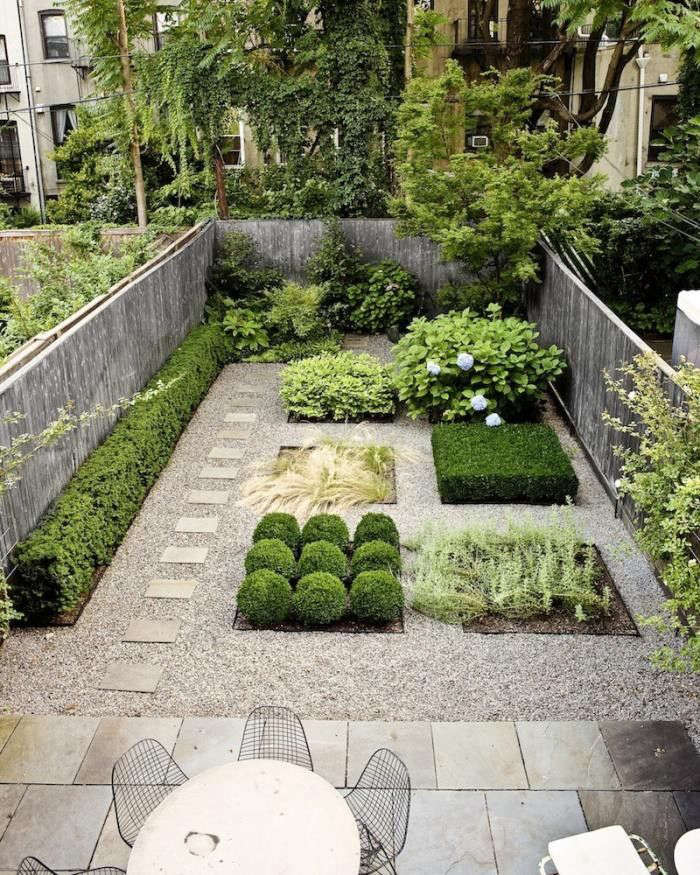Who doesn’t dream of an English estate with groves and gardens and koi ponds? Or perhaps you prefer the ultimate American playground with a pool and a grill? With 80 percent of us living in urban areas, however, the reality is most of us have a small garden.
But don’t despair, even those of us with modest outdoor spaces can take steps to make them a little more grand.
1. Think Big, then Drill Down (a.k.a: Prioritize)

My husband is always pushing to add one more thing to our small Cape Cod plot. At any given time he’s wanted a patio, a kitchen garden, an orchard, a hot tub, and a sandbox for the kids. (This last was my favorite, since we live across the street from the beach!)
I get it. All those things would be great, IF we had a large yard. But a small yard simply can’t be all things to all people. Cramming too may “amenities” into a minimal space results in disordered, cluttered chaos. So the first thing to do when faced with a small garden is to decide what you absolutely can’t live without—an outdoor entertaining space; a kitchen garden; a playground—and make that the priority.
2. Make a Plan

Now that you have your priorities straight, make a plan. Hire a landscape architect or garden designer to help execute your vision in the most efficient manner. There are also many apps and websites to assist you in creating a layout. Even a simple sketch will do. With a plan in hand, you will be able to make the most of your small outdoor space. You may even find you actually have room for that hot tub.
3. Create Distinct Zones or Outdoor Rooms

Just as indoor spaces are defined by rooms with distinct functions, the outdoors benefits from similar organizing zones. For example, have you ever seen a tiny yard with, say: a grill, lawn furniture, garden, and swing set, all haphazardly placed? Looks cluttered. But take that same space and add a small patio on which to gather the grill and furniture, plant an herb garden around it as a border, then orient the swing set so that it perpendicular to one end. Suddenly it all appears more inviting. A simple organizing principle, a deck, pergola, or low hedge, that gathers disparate elements will help the eye digest what it sees. In short, organization makes a small yard look bigger.
4. Grow Up (Use Vertical Space)

Limited your acreage may be, but most likely the sky’s the limit on air space. Vertical elements will help your yard claim this space for its own, enhancing the feeling of spaciousness. Not only can you emphasize the vertical with tall plants, in an urban setting you can actually grow things on surrounding walls or trellises.
5. Clear a Pathway

Think of a road disappearing toward the horizon. Anything that draws your eye through a space helps create the illusion of more of it.
6. Furnish to Scale

As with minimal indoor spaces, furnishing a tiny yard is all about scale. Instead of bulky furnishings made of teak, consider sleeker bistro furniture or cafe chairs. Rattan or wicker is also lighter and will allow light and air to travel around and through it, creating a sense of dynamism and space. If your heart is set on sturdier furnishings, consider something lower to the ground, such as Adirondack chairs, which leave room for more space above them.
7. Layer a Border Garden

Maximize your garden without encroaching on limited lawn space by planting flora of different heights. For example, a dwarf cherry will give you a desired vertical element, but also preserves space below for other specimens of medium height. This layered approach allows you to plant more, without looking cramped or crowed.
8. Construct an Enfilade

Even more dramatic than a path, an enfilade of hedges or trellises will draw your eye through a small yard, creating the illusion of more space.
9. Create Curves

As with any space, a sense of movement creates the feeling of more space. So instead of straight lines, experiment with curves. Try an arched hedge, or cloud pruned shrubs, or undulating edges on the garden. These pleasing curves will draw the eye around the space, creating a sense of dynamism.
10. Use Texture to Create Visual Interest

Texture is another way to create visual interest and movement without overwhelming the viewer. Consider grasses that gently wave in the breeze or a border of undulating sedge grass.
11. Make a Statement with a Few Giant Plants

This advice may seem counter-intuitive for a small yard, but again, it all boils down to creating a sense of order. Planted among smaller types larger specimens provide a resting spot for the eye. Or try a specimen tree to one side of your yard.
12. Use Containers in Nooks and Crannies

Not only do planters allow you to take advantage of small spaces, they also create flexibility, which is vital in a small space. Say you want to make room on the deck to accommodate a larger dinner party. Just move some planters out of the way. Available in different heights, containers are also great for that layered look.

13. Merge the Inside and the Out

To help create the illusion of more space outside, borrow some from the inside. Floor-to-ceiling windows or generous doors will help blur these lines.
14. Forced Perspective

Renaissance painters employed it, and so can you. Strong horizontal lines and a central path create the optical illusion of elongated space.
Want more small-garden inspiration?
- Ask the Expert: 10 Tips to Transform a Tiny Balcony into an Instant Garden with Isabelle Palmer
- A Secret Courtyard Garden in Piccadilly, Ancient Tree Ferns Included









Have a Question or Comment About This Post?
Join the conversation